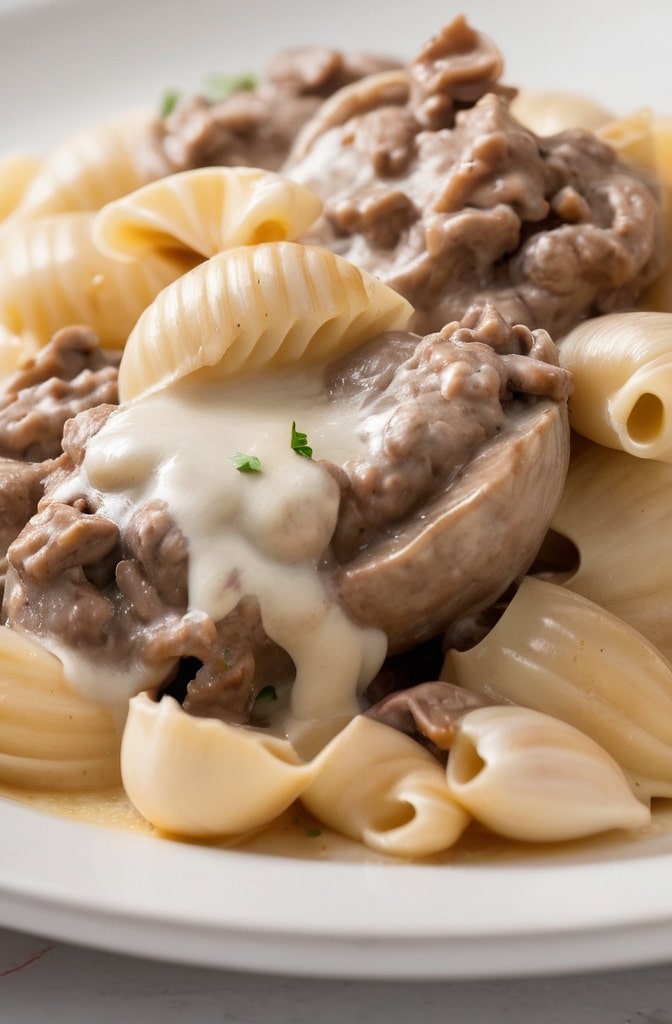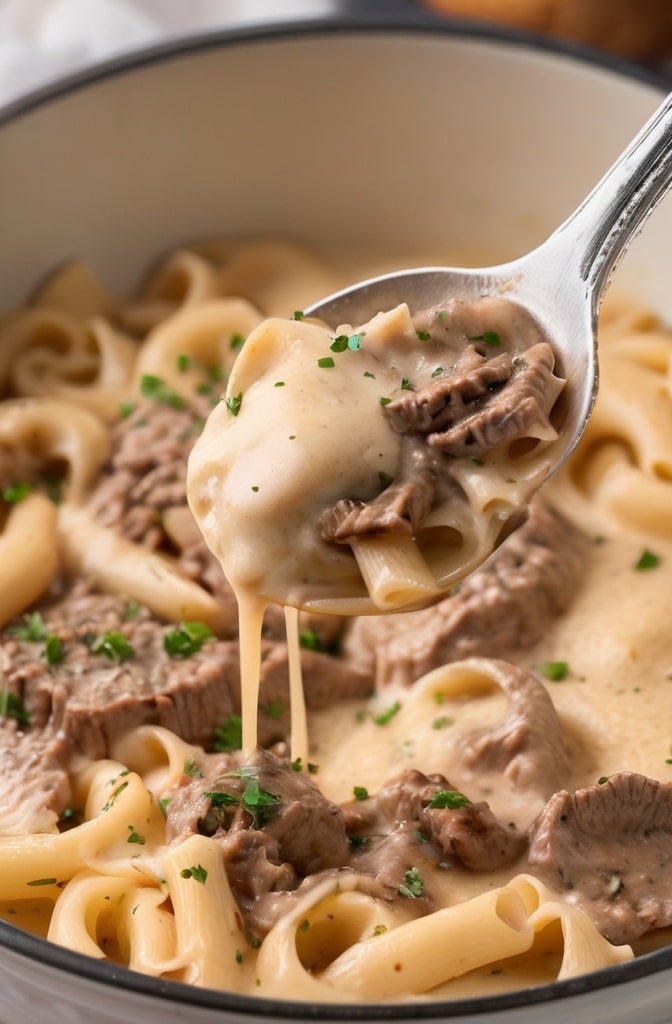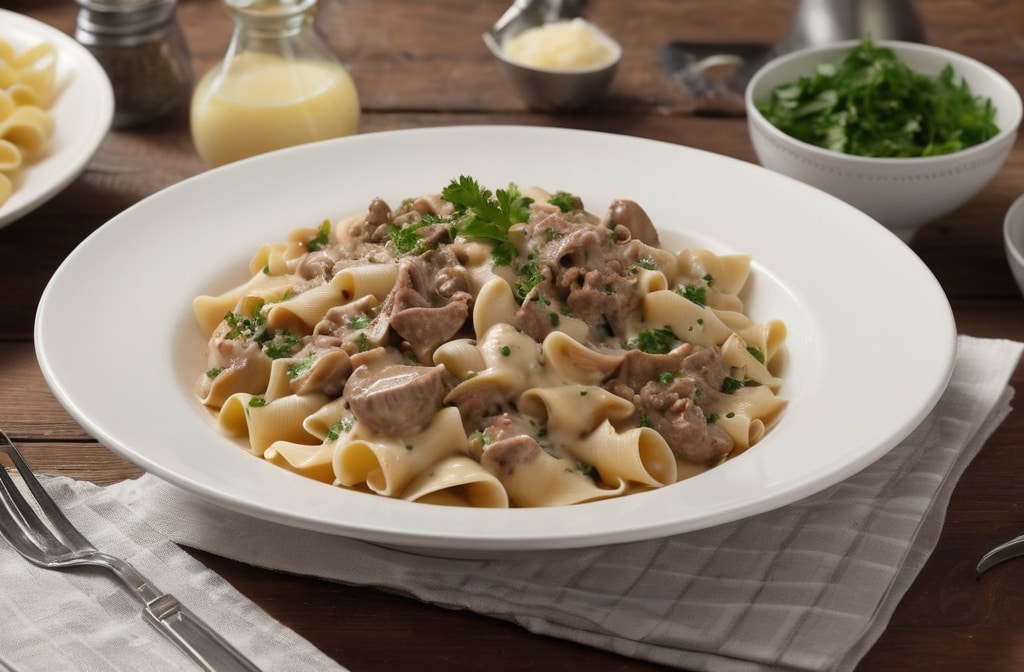Creamy Beef and Shells – a dish that somehow manages to feel like a hearty hug on a cold day, yet can shine just as brightly at a family dinner. It’s one of those recipes that’s easy to make, super satisfying, and, dare I say, better than the sum of its parts. Think of perfectly cooked pasta shells soaking up a rich, creamy beef sauce, with flavours that seem to mingle together in the best way possible. But what makes it so irresistibly good? Let’s dive in and find out why this dish deserves a spot in your weekly rotation.
Ingredients & Substitutions
Creamy Beef and Shells requires a fairly simple list of ingredients, but how you choose them can make a big difference. First, you’ve got your ground beef – lean or not, it’s your choice, though I always prefer a bit of fat for flavour. For a leaner option, turkey or chicken work just as well, though you won’t get that rich beefy flavour. The pasta? Large shell pasta is the MVP here, but if you can’t find it, any other pasta shape will work – just make sure it’s something that can hold that creamy sauce.
Then, you’ll need heavy cream or milk to create that lush base for the sauce. Don’t skip the garlic – the more, the better. A little grated Parmesan cheese adds depth, and a bit of chicken broth keeps it from being too heavy. Substituting plant-based cream for dairy is an easy fix for dairy allergies, and vegan Parmesan can be swapped in, too. If you’re feeling adventurous, toss in a sprinkle of nutmeg – trust me, it’s a game-changer.
Step-by-Step Instructions
Creamy Beef and Shells starts with browning the beef. I know, it’s simple, but here’s the trick – don’t rush it. Let the beef get a nice, crispy brown around the edges. That Browning? It’s the foundation of flavourr. Once the beef is cooked, pull it out and drain any excess fat.
Next, sauté the garlic in the same pan. Let it cook just until fragrant, about a minute – don’t let it burn, or it’ll turn bitter. Add your chicken broth next, scraping up all the flavorful bits stuck to the pan. This step is key – those little bits bring so much to the dish. Once the broth starts to simmer, stir in the heavy cream. You want that rich, creamy texture, so take your time with this step.
Now, bring the beef back into the pan, and throw in the cooked pasta shells. Let everything come together on low heat. This is where magic happens, people. The pasta absorbs the sauce, making each bite feel indulgent. A little salt, a touch of pepper, anf course, a sprinkle of Parmesan to finish things off.

Cooking Techniques & Science
Why does this dish work so well? Well, the key technique here is building layers of flavor, especially in the first few steps. Browning the beef first caramelises the natural sugars in the meat, creating deep, savoury flavours. The garlic, sautéed separately, helps infuse the oil with aromatic goodness, which then gets released into the cream and broth mixture.
Speaking of the cream, it’s not just for texture – fat helps carry flavours, which is why using a good amount of cream gives the sauce that luxurious mouthfeel. And don’t skimp on simmering the sauce either – that’s how it thickens up and coats the pasta shells beautifully.
Now, a quick note about the pasta. Cooking it al dente is a must – it’ll continue to cook in the sauce, so you don’t want it to turn mushy. Plus, the slight resistance when you bite into it adds a perfect contrast to the creamy sauce.
Serving & Pairing Suggestions
Serving this dish is all about making it feel indulgent. A little extra grated Parmesan on top? Always a good idea. For a touch of freshness, sprinkle some fresh herbs like parsley or basil right before serving. I like to serve it with a crisp salad, something with a tangy vinaigrette to balance the richness of the beef and cream.
Pairing it with a glass of red wine is always a hit. Something medium-bodied, like a Chianti or Zinfandel, will cut through the creaminess without overwhelming the flavours of the beef. As for side dishes? Roasted vegetables – carrots, Brussels sprouts, or even a side of garlic bread – will complement the creamy texture of the dish perfectly.

Conclusion
Creamy Beef and Shells is more than just a comforting dinner – it’s a lesson in how simple ingredients can be transformed into something extraordinary. The rich, velvety sauce, combined with hearty pasta andsavouryy beef, creates a balanced, flavorful dish that is both filling and indulgent. The best part? It’s adaptable. You can easily tweak the recipe to suit dietary needs or preferences, all while keeping that signature creamy richness intact.
Before you go, here are a few expert tips: Make sure you’re using high-quality cream, as it plays a huge role in the sauce’s texture. Don’t overcook the pasta, and let the beef get nice and crispy before adding it back into the pan. If you’re after a bit of heat, toss in a pinch of red pepper flakes. You’ll be amazed at how quickly this dish comes together!
FAQs
What type of ground beef should I use for Creamy Beef and Shells?
You can use any type of ground beef, but I recommend 80/20 ground beef for the besflavouror and texture. If you want something leaner, ground turkey or chicken works too.
Can I use a different type of pasta?
Yes! While large shells are ideal for this dish, any pasta shape that can hold sauce will work. Try rigatoni, penne, or even farfalle.
Can I make this dish ahead of time?
Definitely! You can make the sauce and beef mixture ahead of time, then just cook the pasta when you’re ready to serve. Just reheat the sauce and mix it in with the fresh pasta. It’ll still be delicious.
Is there a dairy-free version of this dish?
Yes, you can substitute plant-based cream and vegan cheese for a dairy-free version. Coconut cream or cashew cream makes for a great replacement for the heavy cream.
Can I add vegetables to this recipe?
Absolutely! You can add vegetables like spinach, mushrooms, or bell peppers. Just sauté them with the garlic to incorporate them into the sauce.

Olivia P. is a seasoned food blogger at Tastywink, sharing delicious, easy-to-follow recipes inspired by him passion for home cooking. With years of culinary blogging experience, he brings flavor, creativity, and a personal touch to every dish.
